For guitarists, studio monitors are not just a piece of equipment; they are a crucial tool that empowers them to capture and refine their music with precision and clarity. Unlike traditional speakers, which are designed to enhance the listening experience, studio monitors provide a neutral and accurate representation of sound, allowing guitarists to make informed decisions about their tone and technique.
Here are Some Features to Look for While Buying Studio Monitors for Guitars:
- Woofer Size and Tweeter Size: The woofer and tweeter are the two primary components of a studio monitor, responsible for reproducing low and high frequencies, respectively. For guitarists, a woofer size of 5 to 8 inches is ideal for capturing the full range of guitar tones, while a tweeter size of 1 inch or larger ensures crisp and clear high-end detail.
- Power: Power output is measured in watts and determines the maximum volume a studio monitor can produce. For home studios or smaller recording environments, 50 to 75 watts of power is usually sufficient. However, if you plan to use your monitors in larger spaces or at higher volumes, consider options with 100 watts or more of power.
- Frequency Response: Frequency response refers to the range of frequencies a studio monitor can accurately reproduce. For guitar, a frequency response of at least 50 Hz to 20 kHz is recommended to capture the full spectrum of guitar sounds.
Navigating the vast array of studio monitors available can be daunting, especially for those new to the world of audio engineering. To help you make an informed decision, we’ve compiled a “Buying Guide” highlighting the key features to consider when selecting studio monitors for guitar, along with in-depth reviews of top-rated options.
Outline
ToggleBest Studio Monitors for Guitar Table
| Best Studio Monitors for Guitar | Woofer size and Tweeter size | Power | Frequency Response | Buy Now |
|---|---|---|---|---|
| PreSonus Studio Monitors | 3.5" and 1" | 50 Watts | 30Hz – 200Hz | Check On Amazon |
| JBL Studio Monitors | 5" and 1" | 82 Watts | 43Hz – 24kHz | Check On Amazon |
| Edifier Studio Monitors | 4" and 1" | 42 Watts | 60Hz - 20KHz | Check On Amazon |
| KRK Studio Monitors | 5" and 1" | 20 Watts | 56Hz - 30kHz | Check On Amazon |
| M-Audio Studio Monitors | 3.5" and 1" | 120 Watts | 80Hz – 22kHz | Check On Amazon |
| Mackie Studio Monitors | 8" and 1" | 85 Watts | 60Hz – 20kHz | Check On Amazon |
| Yamaha Studio Monitors | 5" and 1" | 70 Watts | 54Hz - 30kHz | Check On Amazon |
Best Studio Monitors for Guitar Chart
1. PreSonus Studio Monitors
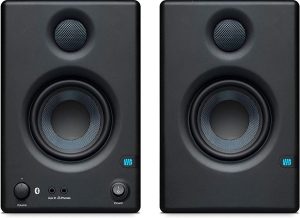
The compact and stylish design, coupled with easy-to-use controls, makes it a perfect fit for multimedia enthusiasts, gamers, music lovers, and content creators. With a 50W Class AB amplification system, the Eris E3.5 BT offers affordability without compromising performance. Whether you’re editing videos, gaming, or enjoying music, these studio monitors enhance your audio experience with precision and style.
Best Features:
- Studio-quality sound at an affordable price.
- Bluetooth 5.0 wireless connectivity for easy streaming.
- Compact and stylish design that fits anywhere.
- Accurate overall sound with a wide sweet spot.
- Multiple input configurations for compatibility with a variety of devices.
Pros:
- Clear, detailed audio with a balanced frequency response.
- Punchy bass and crisp highs.
- Reliable Bluetooth connectivity.
- Great value for the price.
Cons:
- It has too small driver(size).
2. JBL Studio Monitors
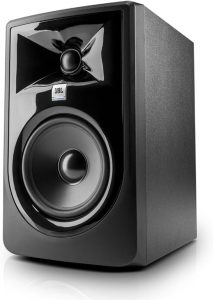
Best Features:
- Stunning detail, precise imaging, and wide sweet spot.
- Impressive dynamic range.
- 82 watts of total power.
- Sleek, modern design.
- Deep, accurate, and tightly controlled bass.
- Soaring, immaculately detailed highs.
Pros:
- Reliable and accurate.
- Good for critical listening and mixing.
- Versatile.
- Durable.
- Great sound quality.
Cons:
- Not ideal for mixing in large rooms.
3. Edifier Studio Monitors
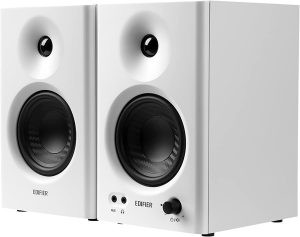
Additional features include adjustable frequency knobs, a front headphone output, and a built-in microphone for added functionality. Edifier, with over 25 years in the audio industry, brings these studio monitors without compromising on quality. Experience professional studio sound with the Edifier MR4, a choice for those seeking a straightforward audio solution for music production and listening.
Best Features:
- Professional-grade sound quality with a near-flat response curve.
- Versatile connectivity options for various audio sources.
- Dual mode design for accurate sound reproduction and enjoyable listening.
- Built-in microphone for enhanced functionality.
- Excellent value for money.
- Stylish and compact design.
Pros:
- Excellent sound quality for the price.
- Clear, crisp highs and deep, rich bass.
- Versatile connectivity options.
- User-friendly controls.
- Compact and stylish design.
Cons:
- Not fine-grained volume control.
4. KRK Studio Monitors
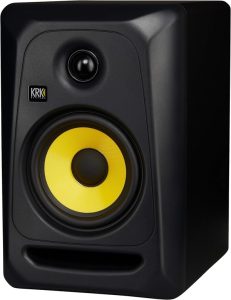
User-friendly features like high/low-frequency controls, a +2dB KRK Bass Boost switch, and a system-optimized auto-limiter offer customization options and speaker protection. Durable with a heavy-duty enclosure and front-firing port, the Classic 5s comes with two 10′ XLR-M to XLR-F cables and foam isolation pads, ensuring a convenient and reliable studio monitoring solution for musicians, producers, and engineers seeking accuracy, durability, and ease of use.
Best Features:
- Flat frequency response for accurate mixing.
- Deep bass extension for monitoring low frequencies.
- High/low-frequency controls and +2dB KRK Bass Boost switch for customization.
- System-optimized auto-limiter for speaker protection.
- Durable heavy-duty enclosure with front-firing port.
- Includes two 10′ XLR-M to XLR-F cables and two foam isolation pads.
Pros:
- Accurate sound reproduction.
- Wide frequency response.
- Customizable sound.
- Durable construction.
- Easy to place.
- Includes all necessary cables and accessories.
Cons:
- Takes some time to wake up from sleep.
5. M-Audio Studio Monitors
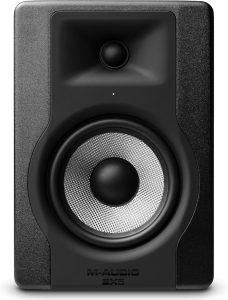
The Acoustic Space Control feature allows you to customize the sound output to your listening environment, ensuring sonically true and reassuringly accurate sound reproduction. With precision positioning facilitated by pin-hole LEDs, the M-Audio BX5 D3 is the ideal choice for those seeking a professional-grade studio monitor that combines accuracy, versatility, and convenience in a home studio setup. As it comes with only a single monitor you need to buy a pair to complete your set-up.
Best Features:
- Accurate sound reproduction.
- Wide frequency response.
- Versatile connectivity options.
- Acoustic Space Control for customizable sound.
- Conveniently located pin-hole LEDs for precise speaker placement.
Pros:
- Great value for the price.
- Punchy bass response.
- Clear and detailed highs.
- Easy to set up and use.
- Durable construction.
Cons:
- It sometimes gets hot while working.
6. Mackie Studio Monitors
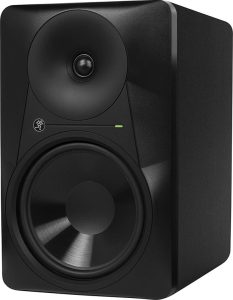
With a 1″ silk dome tweeter delivering detailed high-end and vocal clarity, paired with an 8″ polypropylene woofer for responsive low frequencies, the MR824 ensures a balanced and dynamic sound profile. Powered by 85 watts of bi-amplified Class A/B amplification, this monitor delivers clear, distortion-free sound. With features like Acoustic Space Control for studio environment optimization and balanced XLR and TRS inputs, the MR824 stands out as an excellent, affordable choice for those seeking quality, accuracy, and versatility in a studio monitor.
Best Features:
- Affordable price for professional-grade studio monitors.
- Logarithmic waveguide design for ultra-wide listening sweet spot and enhanced stereo imaging.
- Detailed highs and responsive lows.
- 85 watts of bi-amplified Class A/B amplification.
- Variety of inputs, including XLR and TRS.
Pros:
- Great sound quality for the price.
- Accurate reproduction of all frequencies.
- Wide listening sweet spot.
- Powerful amplification.
- Versatile connectivity.
Cons:
- The monitors are not very portable.
7. Yamaha Studio Monitors
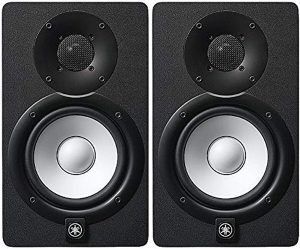
Tailor the sound to your room’s acoustics with two response controls, while the XLR and TRS phone jack inputs accommodate a range of balanced and unbalanced sources. Housed in a low-resonance enclosure with advanced noise reduction technology, the HS5 not only eliminates unwanted resonance but also ensures durable construction for long-lasting, high-quality performance. If you seek a versatile studio monitor with XLR connectivity and a bass boost feature, the Yamaha HS5 stands out as an excellent choice for critical listening and nuanced audio capture.
Best Features:
- Accurate sound reproduction.
- Wide frequency response.
- Bi-amp design with separate dedicated amps for the woofer and tweeter.
- Two response controls to adapt the sound to your room.
- XLR and TRS phone jack inputs.
- Low-resonance enclosure design.
- Advanced noise reduction technology.
Pros:
- Excellent value for money.
- Durable construction.
- Versatile design for a variety of applications.
- Trusted by professional musicians and producers worldwide.
Cons:
- Not as loud as some other studio monitors in this price range.
Buying Guide for Best Studio Monitors for Guitar
Here is the list of key factors that have to be taken into account while shopping for the top-selling studio monitors for guitars.
1. Woofer and Tweeter Size
The woofer and tweeter are the two fundamental components of a studio monitor, each responsible for reproducing a specific range of frequencies. The woofer, typically larger in size, handles the lower frequencies, encompassing the bass and mid-bass regions. The tweeter, on the other hand, focuses on the higher frequencies, capturing the treble and upper-midrange details.
For guitarists, a woofer size of 5-inch to 8-inch is generally considered appropriate for home studios and smaller recording setups. This size range provides a balance between bass reproduction and overall clarity, ensuring that both the low-end rumble and the intricate guitar melodies are accurately represented.
2. Power
Power, measured in watts, indicates the amount of electrical energy that a studio monitor can convert into acoustic energy. Higher power translates to louder output and the ability to handle dynamic peaks without distortion.
For guitarists, a power output of 50 watts to 75 watts per monitor is typically sufficient for most home studio and practice space applications. However, if you plan to use your monitors for larger rooms or live performances, consider opting for monitors with a higher power rating.
3. Frequency Response
Frequency response is the range of frequencies that a studio monitor can accurately reproduce. It is typically specified as a lower and upper-frequency limit, such as 50 Hz to 20 kHz.
A wider frequency response ensures that all the sonic nuances of your guitar playing are captured, from the deep bass tones to the sparkling highs. For guitarists, a frequency response of at least 50 Hz to 20 kHz is recommended to encompass the entire range of audible frequencies.
4. Amplification Type
Amplification class/type refers to the method by which electrical signals are converted into acoustic sound waves. Two common types of amplification in studio monitors are Class AB and Class D.
Class AB amplifiers are known for their warm and full sound, but they tend to generate more heat and consume more power compared to Class D amplifiers. Class D amplifiers, on the other hand, are more efficient and generate less heat, making them a popular choice for modern studio monitors.
5. Sensitivity
Sensitivity, measured in decibels (dB), indicates the amount of sound pressure produced by a studio monitor in response to a given electrical input. Higher sensitivity means that the monitor can produce louder sound with less power.
For guitarists, a sensitivity rating of 85 dB to 90 dB is considered adequate for most home studio and practice space environments. However, if you plan to use your monitors in louder settings, consider opting for monitors with a higher sensitivity rating.
6. Connectivity Technology
Studio monitors typically offer a variety of connectivity options to accommodate different audio sources and interfaces. Common connections include:
- XLR: Balanced connectors that provide the best signal-to-noise ratio for professional studio environments.
- TRS (balanced): Balanced connectors similar to XLR but often used in smaller studio setups or with consumer-grade audio interfaces.
- RCA: Unbalanced connectors commonly found on older equipment and consumer electronics.
- AUX: Unbalanced connectors are often used for connecting portable devices, such as smartphones or tablets.
7. Signal-to-Noise Ratio
The signal-to-noise ratio (SNR) is a measure of the clarity of an audio signal. It represents the ratio between the desired audio signal and the unwanted background noise. A higher SNR indicates a cleaner and more transparent sound.
For guitarists, a signal-to-noise ratio of at least 70 dB is recommended to ensure that your guitar tone is not obscured by background noise. Studio monitors with a higher SNR, such as those with an SNR of 80 dB or higher, will provide even greater clarity and detail.
8. Type of Studio Monitors
Studio monitors come in two main types: active and passive. Active monitors have built-in amplifiers, while passive monitors require an external amplifier to power them.
- Active Studio Monitors: Active studio monitors are a popular choice for guitarists due to their convenience and ease of use. They offer plug-and-play functionality and eliminate the need for a separate amplifier. Active monitors are typically more expensive than passive monitors, but they provide a more streamlined and user-friendly experience.
- Passive Studio Monitors: Passive studio monitors may be a good option for guitarists who have an existing amplifier or who want more control over their sound. Passive monitors can be less expensive than active monitors, but they require an external amplifier to function.
9. Sound Quality
The sound quality of studio monitors is subjective and depends on individual preferences. However, some common factors to consider include:
- Flatness: A flat frequency response means that the studio monitor reproduces all frequencies with equal emphasis. This is important for guitarists, as it allows you to hear your tone accurately without coloration.
- Imaging: Imaging refers to the ability of a studio monitor to create a realistic stereo image. Good imaging allows you to distinguish individual instruments in a mix and hear the spatial relationships between them.
Best Studio Monitors for Guitar – FAQs
Ans: Owning high-quality studio monitors can elevate your music production experience, providing an accurate representation of guitar and bass tones when using plugins for guitars and bass.
Ans: Amplifiers generate sound, while studio monitors are designed for sound monitoring.
Ans: For precise sound reproduction in music production, a stereo setup is essential. This involves using two studio monitors, as stereo sound is achieved through two distinct audio channels, each directed to its own monitor.
Ans: Monitors with a size of 5 inches or smaller are suitable. Speakers below 5 inches may compromise low-frequency reproduction to some degree. It’s important to verify your mixes on alternative systems like car stereos, hi-fi, or headphones.
Ans: While many studio monitors excel in low-end performance, if your project demands extensive low-end monitoring, adding a studio subwoofer to your setup can be a valuable enhancement.
Conclusion
The best studio monitors for guitar depend on several factors, including your budget, the size of your studio, and the type of music you play. However, all of the studio monitors on this list are great options for guitarists, and they offer a good balance of features, performance, and value.
Based on the seven studio monitors listed, the following recommendations are made for guitarists:
- Best overall: Yamaha Studio Monitors, is a popular choice for guitarists due to its flat frequency response and accurate sound reproduction. It has a 5-inch woofer and a 1-inch tweeter, and it delivers a frequency response range of 54 Hz to 30 kHz. The HS5 also has room control and high-trim response controls, which allow you to adjust the monitor’s sound to suit your listening environment and monitor placement.
- Best value: JBL Studio Monitors, is another great option for guitarists on a budget. It offers similar sound quality to the Yamaha HS5, but it is slightly less expensive. The 305P MkII also has a built-in bass boost switch, which can help get more low-end out of your monitors.
- Best for beginners: KRK Studio Monitors, is a good option for beginners who are looking for a pair of reliable and affordable monitors. They have a 5-inch woofer and a 1-inch tweeter, and they deliver a frequency response range of 43 Hz to 20 kHz. The KRK 5″ Classic also has a front-facing bass port, which can help to improve the low-end response of the monitors.
Ultimately, the best way to choose the right studio monitors for you is to try them out and see which ones you like best. If possible, try to test them out with your own guitar and amp so that you can get a better idea of how they’ll sound in your studio environment.

